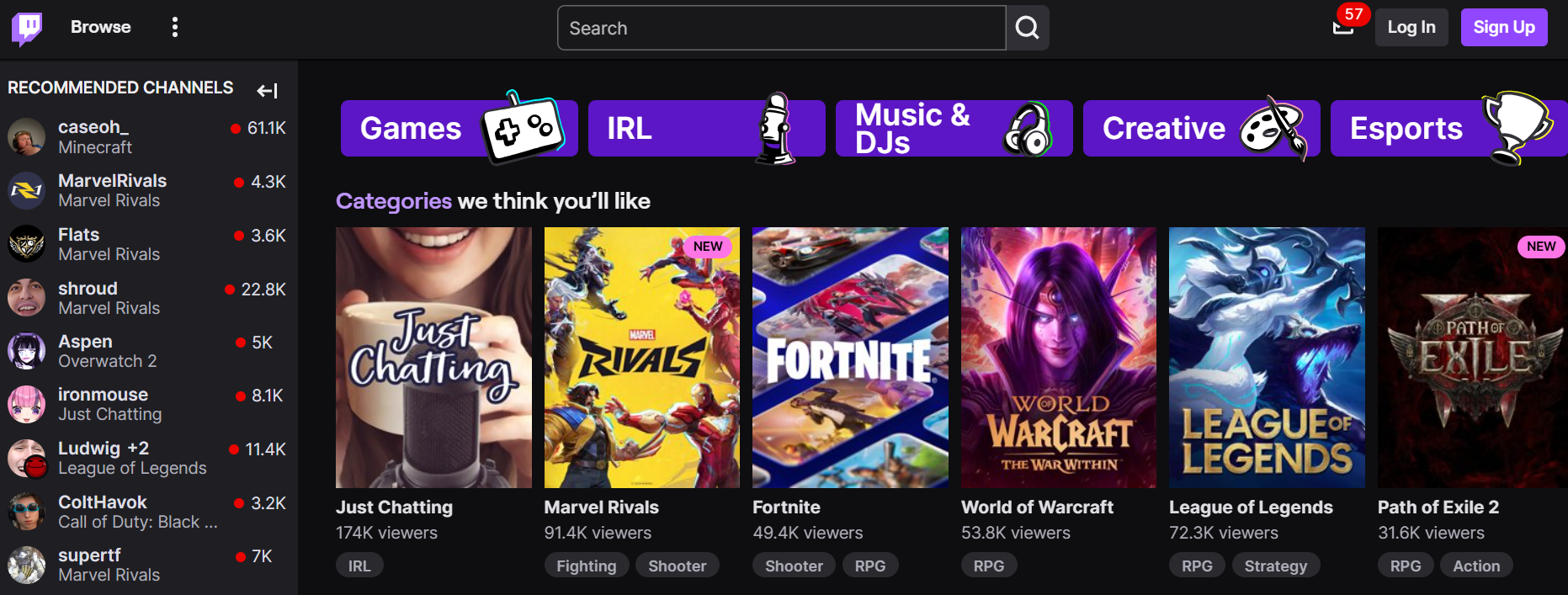Starting a webcam business can be both exciting and challenging, but it comes with its fair share of challenges, especially in today’s highly competitive digital space.Whether you’re an aspiring entrepreneur or a seasoned content creator, you’ve likely wondered: how do I stand out, attract the right audience, and ensure consistent revenue?
From understanding legal complexities to choosing the best platforms, setting up a webcam business requires strategic planning and industry insights. This guide, “How to Start a Webcam Business,” breaks down the essential steps, addresses common challenges like finding your niche, building trust, and handling technical hurdles, ensuring you’re equipped to launch and scale a thriving webcam business that meets your goals.
Understanding Webcam Business
A webcam business involves providing live streaming and interactive services using webcam technology, catering to various audiences, including educational platforms and adult entertainment. This market is experiencing significant growth, projected to reach $14.95 billion by 2032, fueled by the increasing demand for virtual interactions and content consumption.

Exploring the Niches: Adult vs. Non-Adult Webcam Businesses
The webcam business can be broadly categorized into adult & non-adult niches, each with its unique appeal and audience.
1. Non-Adult Webcam Business
- Non-adult niches encompass a variety of fields, including fitness coaching, cooking classes, language lessons, gaming, music performances, and motivational speaking.
- These streams cater to a diverse audience and often focus on education, entertainment, or skill development.

- Platforms like Twitch, YouTube Live, and Zoom have popularized non-adult webcam streaming, proving its vast potential.
2. Adult Webcam Business
- This niche involves offering adult-oriented content, typically through live streaming. It is among the most profitable segments of the industry, thanks to high consumer demand and willingness to pay for personalized, real-time interaction.
- Common categories include solo performances, couple shows, fetish-specific streams, and interactive sessions tailored to client preferences.

- Operators in this space must prioritize legal compliance, age verification systems, and secure payment gateways.
Types of Popular Webcam Business Models
Choosing the right operational model is essential to align with your business goals and resources. Here are 3 primary models to consider:
1. Solo Operations
- In this model, you provide services directly to your audience without involving other performers.
- This setup is ideal for individuals who want to establish a personal brand and maintain complete control over their content and revenue.
- Tools such as OBS Studio and streaming platforms like OnlyFans (for adult content) or Patreon (for non-adult content) can help solo operators get started.
2. Hiring Performers or Experts for Studio
- As an entrepreneur, you can recruit performers or subject-matter experts to stream on your platform.
- For the adult niche, this might involve hiring models to create engaging, live content. In non-adult sectors, it could mean onboarding fitness trainers, chefs, or language tutors.
- Managing a team requires investment in recruitment, contracts, training, and platform development, but it allows for diverse content offerings that attract a broader audience.
3. Building a Platform for Independent Creators
- Creating a platform where independent creators can stream their services is a scalable business model.
- This approach involves developing a robust website or app where creators sign up, stream content, and earn revenue through subscriptions, tips, or pay-per-view.
- Examples include:
- Adult Platforms: CamSoda, Chaturbate
- Non-Adult Platforms: Twitch, MasterClass
- Your role would be to manage the platform, handle marketing, ensure smooth user experiences, and implement monetization features like tiered memberships or advertising.
How to Start a Webcam Business
Starting a webcam business requires careful planning and a clear vision. Here’s a step-by-step guide to help you get started:
1. Define Your Business Model
The first step is to determine how your webcam business will operate. Will you run the show solo, hire performers or experts to stream, or build a platform for independent creators?
Your chosen business model shapes everything – from your target audience to your revenue streams. Common revenue sources in the webcam industry include:
- Subscriptions: Offering tiered membership plans for exclusive access.
- Tips & Donations: Allowing viewers to support performers in real time.
- Pay-Per-View Content: Charging for access to premium, on-demand videos.
- Sponsorships and Advertising: Partnering with brands to promote their products or services during live sessions.
Choosing the right model ensures alignment with your goals and sets the foundation for sustainable growth.
2. Create a Business Plan
A well-structured business plan is essential for turning your vision into a thriving operation. Your plan should cover:
- Target Audience and Niche: Define who you’re serving and what makes your content unique.
- Start-Up Costs and Ongoing Expenses: Include expenses like platform setup, equipment, marketing, and performer fees.
- Revenue Projections and Growth Goals: Set realistic financial targets and outline strategies to achieve them.
- Legal Compliance: Address licensing, age verification, content moderation, and data privacy to ensure your business operates lawfully.
- Competitor Analysis and Market Research: Study successful webcam businesses to understand market trends and identify opportunities.
This blueprint provides clarity for your operations and also positions you to secure investments or loans if needed. Remember, a solid business plan is the backbone of your webcam business success.
3. Register Your Business and Meet Legal Requirements
Before you start streaming, you need to establish your webcam business legally.
- Choose a Business Structure: Decide whether to operate as a sole proprietorship, LLC, or corporation. Each structure has implications for taxes, liability, and administration, so research what works best for your business model.
- Register Your Business Name and Domain: Pick a name that resonates with your brand and secure its domain to establish your online presence.
- Obtain Necessary Permits and Licenses: Depending on your location, you may need specific licenses to operate. For adult-oriented webcam businesses, additional permits might apply.
- Adhere to Industry Regulations:
- For adult webcam businesses, comply with age verification laws such as 18 U.S.C. § 2257 in the U.S.
- Implement content moderation policies to avoid issues related to prohibited material.
- Safeguard user and performer privacy with GDPR-compliant data handling practices.
- Secure Contracts: Draft agreements for performers, employees, or partners, covering payment terms, intellectual property rights, and non-disclosure clauses.
- Set Up Payment Processing: Choose a reliable payment processor that supports your business model and ensures compliance with financial regulations.
Taking these steps not only keeps your business legitimate but also builds trust with your audience and partners.
4. Set Up Your Equipment and Space
Whether you’re a creator ready to go live or an entrepreneur launching a studio for performers, setting up your equipment and space is the first step toward building a thriving webcam business.
Here’s what you need:
- High-Quality Webcam: Invest in a 4K resolution webcam to deliver sharp and engaging visuals. A quality camera ensures your streams stand out in a competitive market.
- Professional Lighting: Proper lighting eliminates shadows and highlights your features, creating a visually appealing experience. Ring lights or softbox lighting kits are popular choices.
- Clear Audio Equipment: Crisp audio is just as important as clear visuals. Consider a professional-grade microphone to eliminate background noise and ensure your voice is heard clearly.
- Dedicated Workspace: Choose a quiet, distraction-free space for your streams. Decorate your backdrop to align with your brand, whether it’s sleek and modern, cozy and welcoming, or creatively themed.
- Set Up Streaming Software: Install and configure reliable streaming software or platforms that integrate with your revenue model (e.g., OBS Studio or a specialized cam site solution).
Your setup reflects your professionalism and brand identity, so investing in the right equipment and creating an inviting space will elevate your business’s appeal.
Pro Tip: Choosing the right streaming protocol for adult live streaming can make all the difference! WebRTC vs. RTMP: Discover which one suits your needs for seamless performance and user satisfaction.
Once you’ve laid the groundwork with legal compliance and a professional setup, the next steps are critical for creating an online presence and attracting an audience.
Here’s how to build your platform and promote your webcam business effectively.
5. Build a Website or Platform
Your online presence is the cornerstone of starting a webcam business. You can either operate on an established platform or take full control by creating your own custom website. Here’s how to build your platform:
- Use Website Builders or Hire a Developer: For a custom platform, consider hiring a web developer for a professional touch or use tools like Wix, WordPress to design your site. Or you can use ready-made live webcam site scripts for faster setup and pre-built features.
- Focus on User Experience: Make your website secure, easy to navigate, and visually appealing. Prioritize responsive design to ensure it works seamlessly on all devices.
- Integrate Key Features: Include essential tools like payment gateways for seamless transactions, membership management for subscription-based models, and live-streaming capabilities.
- Prioritize Security: Implement robust cybersecurity measures to protect your content and client data, especially if your business involves sensitive material.
A well-built website positions your brand as credible and professional, offering users a seamless experience that keeps them coming back.
Pro Tip: Feeling overwhelmed by the costs of building a webcam site? Don’t worry! Check out our expert guide for clarity. Start with a simple setup and scale up as your business expands!
6. Market Your Webcam Business
To attract and retain clients, you need a strong marketing strategy for your webcam business. Visibility is key in the competitive webcam industry, and here’s how to achieve it:
- Leverage Social Media: Use platforms like Instagram, TikTok, and X (formerly known as Twitter) to showcase your content, share teasers, and engage with your audience. Consistent posting builds brand recognition and trust.
- Influencer Collaborations: Partner with popular performers or influencers to tap into their fan base and build credibility.
- Email Marketing: Send personalized emails to promote new performers, live shows, or discounts. Offer free trials or premium membership incentives to drive subscriptions.
- Create Niche Content: Start a blog or vlog around your niche to drive organic traffic to your site. Share valuable insights, tips, or behind-the-scenes looks that resonate with your target audience.
- Run Targeted Ads: Invest in paid advertising on platforms like Google Ads or Facebook. Tailor your ads to specific demographics to maximize ROI.
- Engage with Your Community: Host interactive live sessions, Q&A events, or giveaways to deepen your connection with your audience and foster loyalty.
An effective marketing plan not only increases your visibility but also helps you build a loyal client base, ensuring the long-term success of your webcam business.
How to Manage and Grow Your Webcam Business?
Running a webcam business doesn’t stop at launch; maintaining momentum and fostering growth are ongoing efforts. To keep your business thriving, consider these strategies:
- Consistently Engage Your Audience: Regularly introduce fresh and interactive content, such as themed live sessions or behind-the-scenes glimpses. Keep your audience intrigued and coming back for more.
- Expand Your Offerings: Diversify by adding workshops, tutorials, or premium memberships. These additional revenue streams can attract a broader audience and enhance loyalty.
- Leverage Analytics: Use tools to monitor metrics like viewer engagement, revenue trends, and customer feedback. Analyze data to identify strengths and areas for improvement.
- Network in Your Industry: Join industry groups or forums to connect with peers. Networking can provide invaluable insights, support, and opportunities for growth.
Other Effective Management Tips
1. Maintain Strong Performer Relations:
- Offer competitive pay structures, bonuses, and incentives for top performers.
- Provide training sessions on engaging with audiences, using equipment effectively, and personal branding.
- Create an open feedback loop where performers can voice concerns and suggestions.
2. Monitor Performance Metrics:
- Track viewer engagement, average revenue per user (ARPU), and retention rates to evaluate business performance.
- Use analytics to identify popular content types or peak activity hours for targeted improvements.
3. Optimize Technology and User Experience:
- Regularly update your platform to ensure smooth streaming, minimal downtime, and enhanced security features.
- Introduce new tools like virtual gifting, polls, or gamified elements to boost audience engagement.
Growing Your Business
- Explore New Markets: Expand into underserved regions or niches, catering to diverse audiences and preferences.
- Enhance Brand Visibility: Focus on SEO, PR campaigns, and partnerships with influencers or adult content creators to build brand recognition.
- Leverage Technology: Explore innovative technologies like AI chatbots for improved customer support or AR/VR integration for immersive experiences.
- Invest in Loyalty Programs: Reward long-term users with discounts, exclusive content, or early access to features.
Challenges and How to Overcome Them
Starting a webcam business is lucrative, but it’s not without its hurdles. Here’s how to tackle some common challenges:
1. Competition in the Market:
- Challenge: The webcam industry is highly competitive, with numerous platforms vying for audience attention.
- Solution: Differentiate your business by focusing on a specific niche, providing unique features, and investing in personalized customer experiences.
2. Privacy and Security Concerns:
- Challenge: Protecting the personal data of performers and users is paramount.
- Solution: Implement end-to-end encryption, anonymized payment processing, and robust cybersecurity measures. Regular audits and updates can minimize risks.
3. High Performer Turnover:
- Challenge: Retaining talent in the webcam business can be difficult due to burnout or better opportunities.
- Solution: Build a supportive work environment with clear communication, financial incentives, and mental health resources to promote performer satisfaction and loyalty.
4. Payment Processing Issues:
- Challenge: Many payment gateways are hesitant to support adult-related businesses.
- Solution: Partner with adult-friendly payment processors like CCBill or Verotel and diversify payment options to reduce reliance on a single gateway.
5.Cultural and Regulatory Barriers:
- Challenge: Operating in multiple regions can expose your business to varied cultural sensitivities and legal complexities.
- Solution: Conduct thorough market research and consult legal experts in target regions to ensure compliance and cultural alignment.
6. Scaling Challenges:
- Challenge: Rapid growth can lead to technical bottlenecks and operational inefficiencies.
- Solution: Invest in scalable infrastructure and automation tools to handle increased traffic and streamline operations.
7. Marketing Fatigue:
- Challenge: Keeping your platform fresh and engaging is critical but can be resource-intensive.
- Solution: Regularly update your content strategy, introduce seasonal promotions, and engage with users through surveys or polls to keep the experience dynamic.
Final Thoughts
Starting a webcam business requires strategic planning, industry knowledge, and a unique platform to stand out in a competitive market. Key steps include meeting legal requirements, building a strong brand, and leveraging technology for sustainability and profitability. Success hinges on adaptability, innovation, and delivering value to performers and clients. For a head start, xCams by Adent.io offers customizable templates and advanced features, enabling you to launch a scalable and professional webcam platform with ease.
Hi
Start Growing Your Dream Business
with Us!
Aaron
Chief Operating Officer at Adent.io
As the COO of Adent.io, Aaron leads with a vision of innovation, quality, and ethical standards in the adult digital landscape. With over a decade of experience in software solutions tailored for the adult industry, Aaron has played a pivotal role in transforming Adent.io into a trusted name for ready-made adult scripts. These scripts are designed to empower entrepreneurs to build and grow adult websites, from tube sites to membership and webcam platforms, with security and efficiency.

 and Welcome to Adent.io
and Welcome to Adent.io





